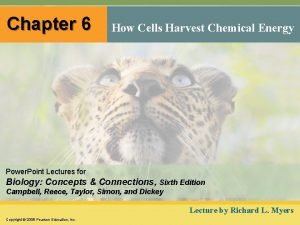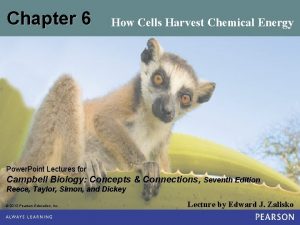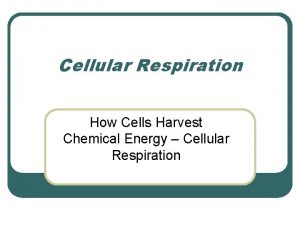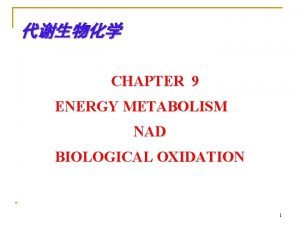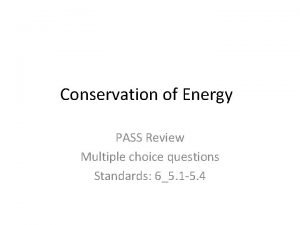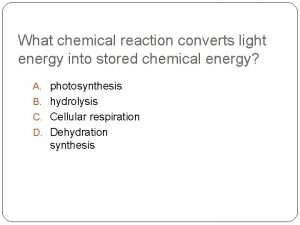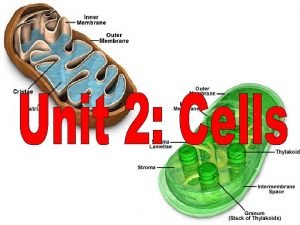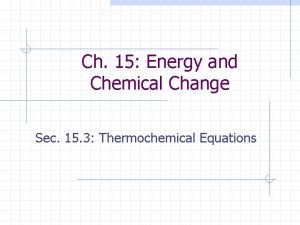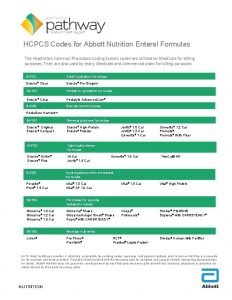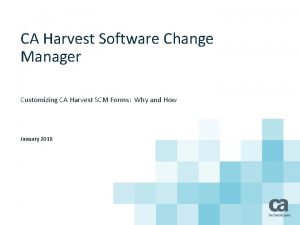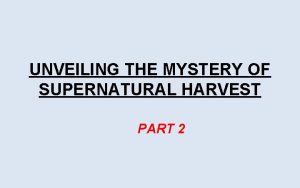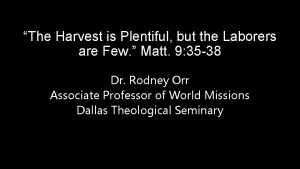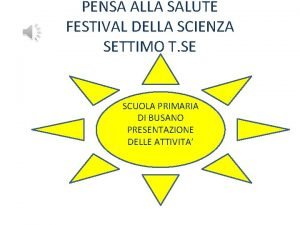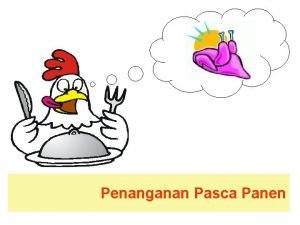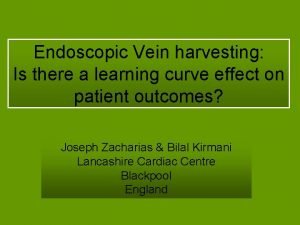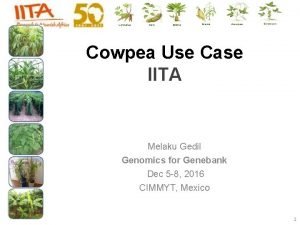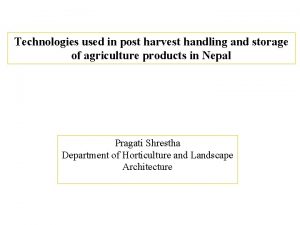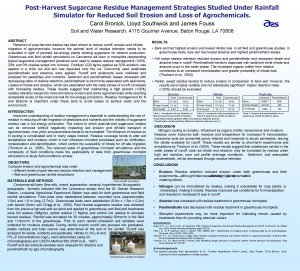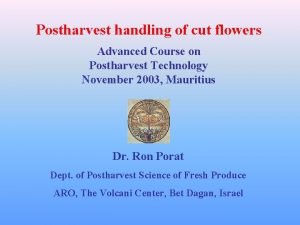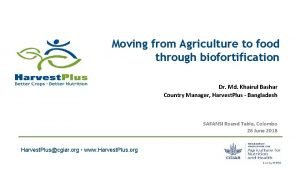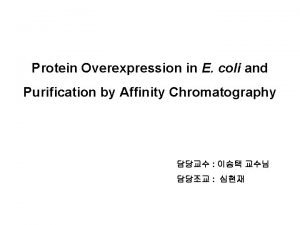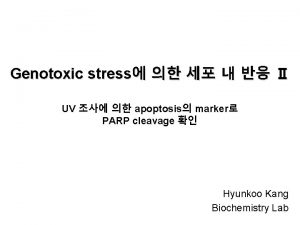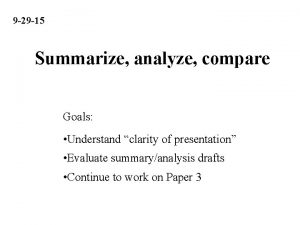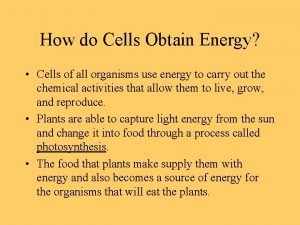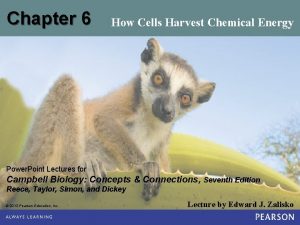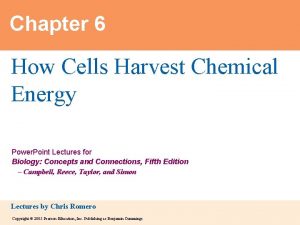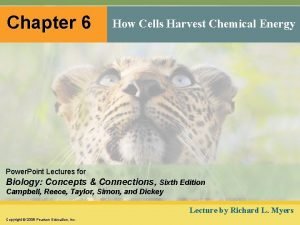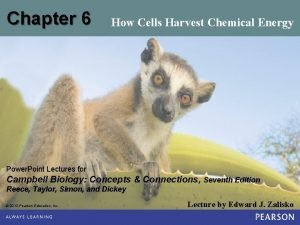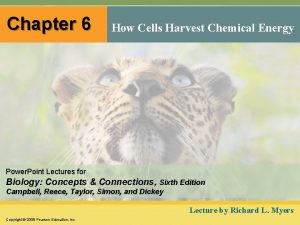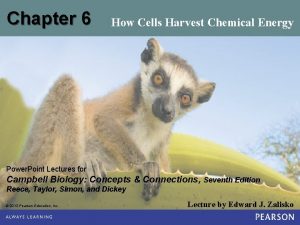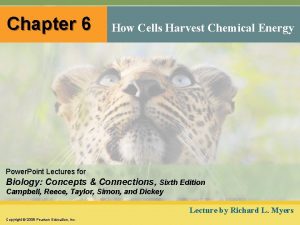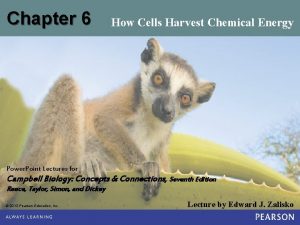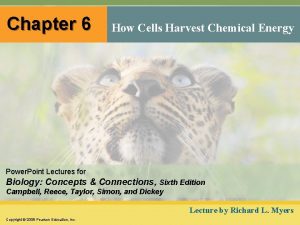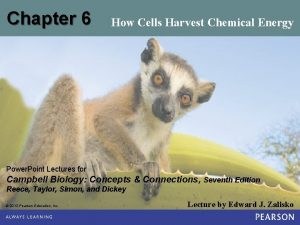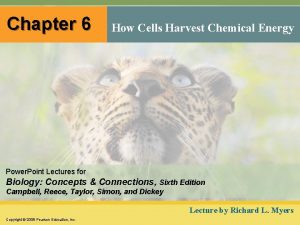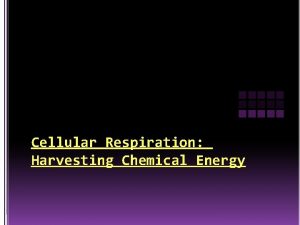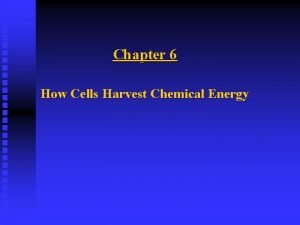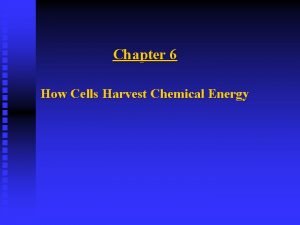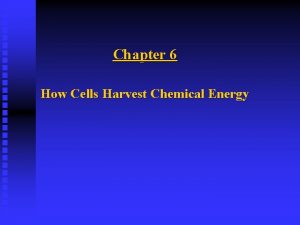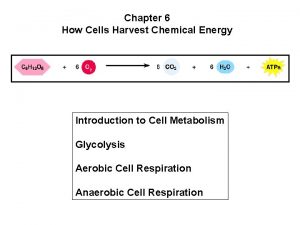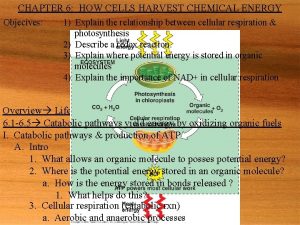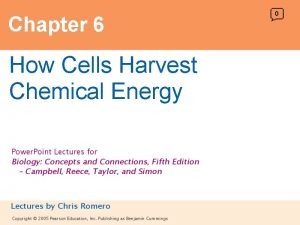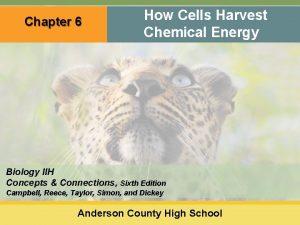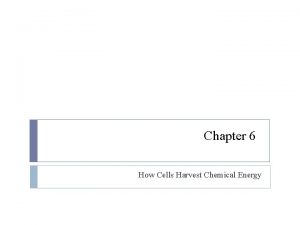Chapter 6 How Cells Harvest Chemical Energy Power






































































- Slides: 70

Chapter 6 How Cells Harvest Chemical Energy Power. Point Lectures Campbell Biology: Concepts & Connections, Eighth Edition REECE • TAYLOR • SIMON • DICKEY • HOGAN © 2015 Pearson Education, Inc. Lecture by Edward J. Zalisko

CELLULAR RESPIRATION: AEROBIC HARVESTING OF ENERGY © 2015 Pearson Education, Inc.

6. 1 Photosynthesis and cellular respiration provide energy for life • Life requires energy. • In almost all ecosystems, energy ultimately comes from the sun. • In photosynthesis, • some of the energy in sunlight is captured by chloroplasts, • atoms of carbon dioxide and water are rearranged, and • sugar and oxygen are produced. © 2015 Pearson Education, Inc.

6. 1 Photosynthesis and cellular respiration provide energy for life • In cellular respiration, • sugar is broken down to carbon dioxide and water and • the cell captures some of the released energy to make ATP. • Cellular respiration takes place in the mitochondria of eukaryotic cells. • In these energy conversions, some energy is lost as heat. © 2015 Pearson Education, Inc.

Figure 6. 1 Sunlight energy ECOSYSTEM CO 2 + H 2 O Photosynthesis in chloroplasts Organic Cellular respiration in mitochondria ATP Heat energy © 2015 Pearson Education, Inc. molecules + O 2 ATP powers most cellular work

6. 2 Breathing supplies O 2 for use in cellular respiration and removes CO 2 • Respiration, as it relates to breathing, and cellular respiration are not the same. • Respiration, in the breathing sense, refers to an exchange of gases. Usually an organism brings in oxygen from the environment and releases waste CO 2. • Cellular respiration is the aerobic (oxygen-requiring) harvesting of energy from food molecules by cells. © 2015 Pearson Education, Inc.

Figure 6. 2 -0 O 2 Breathing CO 2 Lungs O 2 Transported in bloodstream CO 2 Muscle cells carrying out Cellular Respiration Glucose + O 2 ➞ CO 2 + H 2 O + ATP © 2015 Pearson Education, Inc.

6. 3 Cellular respiration banks energy in ATP molecules • Cellular respiration is an exergonic (energyreleasing) process that transfers energy from the bonds in glucose to form ATP. © 2015 Pearson Education, Inc.

6. 3 Cellular respiration banks energy in ATP molecules • Cellular respiration • can produce up to 32 ATP molecules for each glucose molecule, • uses about 34% of the energy originally stored in glucose, and • releases the other 66% as heat. • This energy conversion efficiency is better than most energy conversion systems. • Only about 25% of the energy in gasoline produces the kinetic energy of movement. © 2015 Pearson Education, Inc.

Figure 6. 3 C 6 H 12 O 6 6 O 2 6 CO 2 Glucose Oxygen Carbon dioxide © 2015 Pearson Education, Inc. 6 H 2 O Water ATP Heat

6. 4 CONNECTION: The human body uses energy from ATP for all its activities • Your body requires a continuous supply of energy just to stay alive—to keep your heart pumping and you breathing. © 2015 Pearson Education, Inc.

6. 4 CONNECTION: The human body uses energy from ATP for all its activities • A kilocalorie (kcal) is • the quantity of heat required to raise the temperature of 1 kilogram (kg) of water by 1 C, • the same as a food Calorie, and • used to measure the nutritional values indicated on food labels. © 2015 Pearson Education, Inc.

6. 4 CONNECTION: The human body uses energy from ATP for all its activities • The average adult human needs about 2, 200 kcal of energy per day. • About 75% of these calories is used to maintain a healthy body. • The remaining 25% is used to power physical activities. • A balance of energy intake and expenditure is required to maintain a healthy weight. © 2015 Pearson Education, Inc.

Figure 6. 4 -1 Activity kcal consumed per hour by a 67. 5 -kg (150 -lb) person* Running (8– 9 mph) 979 Dancing (fast) 510 Bicycling (10 mph) 490 Swimming (2 mph) 408 Walking (4 mph) 341 Walking (3 mph) 245 Dancing (slow) Driving a car Sitting (writing) 204 61 28 *Not including kcal needed for body maintenance © 2015 Pearson Education, Inc.

6. 5 Cells capture energy from electrons “falling” from organic fuels to oxygen • How do your cells extract energy from glucose? • The answer involves the transfer of electrons during chemical reactions. © 2015 Pearson Education, Inc.

6. 5 Cells capture energy from electrons “falling” from organic fuels to oxygen • During cellular respiration, • electrons are transferred from glucose to oxygen and • energy is released. • Oxygen attracts electrons very strongly. • An electron loses potential energy when it is transferred to oxygen. © 2015 Pearson Education, Inc.

6. 5 Cells capture energy from electrons “falling” from organic fuels to oxygen • Energy can be released from glucose by simply burning it. • This electron “fall” happens very rapidly. • This energy is dissipated as heat and light and is not available to living organisms. © 2015 Pearson Education, Inc.

6. 5 Cells capture energy from electrons “falling” from organic fuels to oxygen • Cellular respiration is a more controlled descent of electrons and like rolling down an energy hill. • Energy is released in small amounts and can be stored in the chemical bonds of ATP. © 2015 Pearson Education, Inc.

6. 5 Cells capture energy from electrons “falling” from organic fuels to oxygen • The movement of electrons from one molecule to another is an oxidation-reduction reaction, or redox reaction. In a redox reaction, • the loss of electrons from one substance is called oxidation, • the addition of electrons to another substance is called reduction, • a molecule is oxidized when it loses one or more electrons, and • a molecule is reduced when it gains one or more electrons. © 2015 Pearson Education, Inc.

6. 5 Cells capture energy from electrons “falling” from organic fuels to oxygen • A cellular respiration equation is helpful to show the changes in hydrogen atom distribution. • Glucose loses its hydrogen atoms and becomes oxidized to CO 2. • Oxygen gains hydrogen atoms and becomes reduced to H 2 O. © 2015 Pearson Education, Inc.

Figure 6. 5 a Loss of hydrogen atoms (becomes oxidized) C 6 H 12 O 6 + 6 O 2 (Glucose) 6 CO 2 + 6 H 2 O + ATP + Heat Gain of hydrogen atoms (becomes reduced) © 2015 Pearson Education, Inc.

6. 5 Cells capture energy from electrons “falling” from organic fuels to oxygen • An important player in the process of oxidizing glucose is a coenzyme called NAD+, which • accepts electrons and • becomes reduced to NADH. © 2015 Pearson Education, Inc.

Figure 6. 5 b Becomes oxidized NAD+ + 2 H Becomes reduced 2 H+ + 2 © 2015 Pearson Education, Inc. +2 H NADH (carries) 2 electrons) H+

6. 5 Cells capture energy from electrons “falling” from organic fuels to oxygen • NADH delivers electrons to a string of electron carrier molecules, which moves electrons down a hill. • These carrier molecules constitute an electron transport chain. • At the bottom of the hill is oxygen (1/2 O 2), which • accepts two electrons, • picks up two H+, and • becomes reduced to water. © 2015 Pearson Education, Inc.

Figure 6. 5 c NAD+ NADH 2 Energy released and available for making ATP 2 1 − 2 O 2 2 H+ © 2015 Pearson Education, Inc. H 2 O

STAGES OF CELLULAR RESPIRATION © 2015 Pearson Education, Inc.

6. 6 Overview: Cellular respiration occurs in three main stages • Cellular respiration consists of a sequence of steps that can be divided into three stages. • Stage 1: Glycolysis • Stage 2: Pyruvate oxidation and the citric acid cycle • Stage 3: Oxidative phosphorylation © 2015 Pearson Education, Inc.

6. 6 Overview: Cellular respiration occurs in three main stages • Stage 1: Glycolysis • occurs in the cytosol, • begins cellular respiration, and • breaks down glucose into two molecules of a threecarbon compound called pyruvate. © 2015 Pearson Education, Inc.

6. 6 Overview: Cellular respiration occurs in three main stages • Stage 2: Pyruvate oxidation and the citric acid cycle • take place in mitochondria, • oxidize pyruvate to a two-carbon compound, and • supply the third stage with electrons. • The cell makes a small amount of ATP during glycolysis and the citric acid cycle. © 2015 Pearson Education, Inc.

6. 6 Overview: Cellular respiration occurs in three main stages • Stage 3: Oxidative phosphorylation • NADH and a related electron carrier, FADH 2, shuttle electrons to an electron transport chain embedded in the inner mitochondrial membrane. • Most ATP produced by cellular respiration is generated by oxidative phosphorylation, which uses the energy released by the downhill fall of electrons from NADH and FADH 2 to oxygen to phosphorylate ADP. © 2015 Pearson Education, Inc.

6. 6 Overview: Cellular respiration occurs in three main stages • Stage 3: Oxidative phosphorylation • As the electron transport chain passes electrons down the energy hill, it also pumps hydrogen ions (H+) across the inner mitochondrial membrane, into the narrow intermembrane space, and produces a concentration gradient of H+ across the membrane. • In chemiosmosis, the potential energy of this concentration gradient is used to make ATP. © 2015 Pearson Education, Inc.

Figure 6. 6 -1 Electrons carried by Glycolysis Glucose Pyruvate CYTOSOL ATP © 2015 Pearson Education, Inc. Pyruvate Oxidation Citric Acid Cycle NADH FADH 2 Oxidative Phosphorylation (Electron transport and chemiosmosis) MITOCHONDRION Substrate-level phosphorylation Substrate-level ATP phosphorylation ATP Oxidative phosphorylation

6. 7 Glycolysis harvests chemical energy by oxidizing glucose to pyruvate • In glycolysis, • a single molecule of glucose is enzymatically cut in half through a series of steps, • two molecules of pyruvate are produced, • two molecules of NAD+ are reduced to two molecules of NADH, and • there is a net gain of two molecules of ATP. © 2015 Pearson Education, Inc.

Figure 6. 7 a Glucose 2 ADP 2 NAD+ +2 P 2 NADH 2 ATP 2 Pyruvate © 2015 Pearson Education, Inc. +2 H+

6. 7 Glycolysis harvests chemical energy by oxidizing glucose to pyruvate • ATP is formed in glycolysis by substrate-level phosphorylation during which • an enzyme transfers a phosphate group from a substrate molecule to ADP and • ATP is formed. • The compounds that form between the initial reactant, glucose, and the final product, pyruvate, are known as intermediates. © 2015 Pearson Education, Inc.

Figure 6. 7 b Enzyme P Enzyme ADP ATP P Substrate © 2015 Pearson Education, Inc. P Product

6. 7 Glycolysis harvests chemical energy by oxidizing glucose to pyruvate • The steps of glycolysis have two main phases. • In steps 1– 4, the energy investment phase, energy is consumed as two ATP molecules are used to energize a glucose molecule, which is then split into two small sugars. • In steps 5– 9, the energy payoff phase, two NADH molecules are produced for each initial glucose molecule and four ATP molecules are generated. • There is a net gain of two ATP molecules for each glucose molecule that enters glycolysis. © 2015 Pearson Education, Inc.

Figure 6. 7 c-1 -2 Glucose ATP Steps 1 – 3 Glucose is energized, using ATP. Step ENERGY INVESTMENT PHASE 1 ADP P Glucose 6 -phosphate P Fructose 1, 6 -bisphosphate 2 ATP 3 Step 4 A six-carbon intermediate splits into two three-carbon intermediates. ADP P 4 P © 2015 Pearson Education, Inc. P Glyceraldehyde 3 -phosphate (G 3 P)

Figure 6. 7 c-2 -2 P Step 5 A redox reaction generates NADH. P NAD+ 5 P NADH + H+ P 5 P NADH ENERGY PAYOFF PHASE + H+ P ADP Steps 6 – 9 ATP and pyruvate are produced. Glyceraldehyde 3 -phosphate (G 3 P) P P 1, 3 -Bisphoglycerate P 3 -Phosphoglycerate ADP 6 6 ATP P 7 7 P P 2 -Phosphoglycerate 8 H 2 O P P ADP Phosphoenolpyruvate (PEP) ADP 9 9 ATP 8 H 2 O ATP Pyruvate © 2015 Pearson Education, Inc.

6. 8 Pyruvate is oxidized in preparation for the citric acid cycle • The pyruvate formed in glycolysis is transported from the cytosol into a mitochondrion where the citric acid cycle and oxidative phosphorylation will occur. • Two molecules of pyruvate are produced for each molecule of glucose that enters glycolysis. © 2015 Pearson Education, Inc.

6. 8 Pyruvate is oxidized in preparation for the citric acid cycle • Pyruvate does not enter the citric acid cycle but undergoes some chemical grooming in which • a carboxyl group is removed and given off as CO 2, • the two-carbon compound remaining is oxidized while a molecule of NAD+ is reduced to NADH, and • coenzyme A joins with the two-carbon group to form acetyl coenzyme A, abbreviated as acetyl Co. A. • Then two molecules of acetyl Co. A enter the citric acid cycle. © 2015 Pearson Education, Inc.

Figure 6. 8 NAD+ NADH + H+ 2 Co. A Pyruvate Acetyl coenzyme A 1 CO 2 © 2015 Pearson Education, Inc. 3 Coenzyme A

6. 9 The citric acid cycle completes the oxidation of organic molecules, generating many NADH and FADH 2 molecules • The citric acid cycle • is also called the Krebs cycle (after the German. British researcher Hans Krebs, who worked out much of this pathway in the 1930 s), • completes the oxidation of organic molecules, and • generates many NADH and FADH 2 molecules. © 2015 Pearson Education, Inc.

Figure 6. 9 a Acetyl Co. A Citric Acid Cycle 2 CO 2 3 NAD+ FADH 2 3 NADH FAD + 3 H+ ATP © 2015 Pearson Education, Inc. ADP + P

6. 9 The citric acid cycle completes the oxidation of organic molecules, generating many NADH and FADH 2 molecules • During the citric acid cycle • the two-carbon group of acetyl Co. A is joined to a four-carbon compound, forming citrate, • citrate is degraded back to the four-carbon compound, • two CO 2 are released, and • one ATP, three NADH, and one FADH 2 are produced. © 2015 Pearson Education, Inc.

6. 9 The citric acid cycle completes the oxidation of organic molecules, generating many NADH and FADH 2 molecules • Remember that the citric acid cycle processes two molecules of acetyl Co. A for each initial glucose. • Thus, after two turns of the citric acid cycle, the overall yield per glucose molecule is • 2 ATP, • 6 NADH, and • 2 FADH 2. © 2015 Pearson Education, Inc.

6. 9 The citric acid cycle completes the oxidation of organic molecules, generating many NADH and FADH 2 molecules • Thus, after glycolysis and the citric acid cycle, the cell has gained • 4 ATP, • 10 NADH, and • 2 FADH 2. • To harvest the energy banked in NADH and FADH 2, these molecules must shuttle their highenergy electrons to an electron transport chain. © 2015 Pearson Education, Inc.

Figure 6. 9 b-3 Co. A Acetyl Co. A 2 carbons enter cycle 1 Oxaloacetate Citrate NADH + H+ NAD+ 6 NAD+ NADH + H+ 2 Malate Citric Acid Cycle CO 2 H 2 O leaves cycle 5 Alpha-ketoglutarate Fumarate FADH 2 CO 2 4 3 FAD leaves cycle NAD+ Succinate ADP + P NADH + H+ ATP Step 1 Acetyl Co. A stokes the furnace. © 2015 Pearson Education, Inc. Steps 2 – 3 NADH, ATP, and CO 2 are generated during redox reactions. Steps 4 – 6 Further redox reactions generate FADH 2 and more NADH.

6. 10 Most ATP production occurs by oxidative phosphorylation • The final stage of cellular respiration is oxidative phosphorylation, which • involves electron transport and chemiosmosis and • requires an adequate supply of oxygen. • The arrangement of electron carriers built into a membrane makes it possible to • create an H+ concentration gradient across the membrane and then • use the energy of that gradient to drive ATP synthesis. © 2015 Pearson Education, Inc.

6. 10 Most ATP production occurs by oxidative phosphorylation • Electrons from NADH and FADH 2 travel down the electron transport chain to O 2, the final electron acceptor. • Oxygen picks up H+, which forms water. • Energy released by these redox reactions is used to pump H+ from the mitochondrial matrix into the intermembrane space. © 2015 Pearson Education, Inc.

6. 10 Most ATP production occurs by oxidative phosphorylation • In chemiosmosis, the H+ diffuses back across the inner membrane, through ATP synthase complexes, driving the synthesis of ATP. © 2015 Pearson Education, Inc.

Figure 6. 10 a OUTER MITOCHONDRIAL MEMBRANE Intermembrane space H+ Protein complex of electron carriers H+ Mobile electron H+ carriers III H+ H+ Inner mitochondrial membrane H+ H+ H+ Cyt c Q I H+ ATP synthase IV II Electron flow FADH 2 NADH Mitochondrial matrix FAD 1 − O 2 + 2 H+ 2 NAD+ H+ H 2 O Electron Transport Chain Oxidative Phosphorylation © 2015 Pearson Education, Inc. ADP + P ATP H+ Chemiosmosis

6. 12 Review: Each molecule of glucose yields many molecules of ATP • Recall that the energy payoff of cellular respiration involves 1. 2. 3. 4. glycolysis, alteration of pyruvate, the citric acid cycle, and oxidative phosphorylation. © 2015 Pearson Education, Inc.

6. 12 Review: Each molecule of glucose yields many molecules of ATP • The total yield is about 32 ATP molecules per glucose molecule. • The number of ATP molecules cannot be stated exactly for several reasons. • The NADH produced in glycolysis passes its electrons across the mitochondrial membrane to either NAD+ or FAD. Because FADH 2 adds its electrons farther along the electron transport chain, it contributes less to the H+ gradient and thus generates less ATP. • Some of the energy of the H+ gradient may be used for work other than ATP production, such as the active transport of pyruvate into the mitochondrion. © 2015 Pearson Education, Inc.

Figure 6. 12 CYTOSOL MITOCHONDRION 2 NADH Glycolysis 2 Pyruvate Glucose 6 NADH + 2 FADH 2 2 NADH Pyruvate Oxidation 2 Acetyl Co. A Oxidative Phosphorylation (electron transport and chemiosmosis) Citric Acid Cycle O 2 +2 ATP by substrate-level phosphorylation © 2015 Pearson Education, Inc. CO 2 Maximum per glucose: H 2 O +2 ATP by substrate-level phosphorylation + about 28 ATP About 32 ATP by oxidative phosphorylation

FERMENTATION: ANAEROBIC HARVESTING OF ENERGY © 2015 Pearson Education, Inc.

6. 13 Fermentation enables cells to produce ATP without oxygen • Fermentation is a way of harvesting chemical energy that does not require oxygen. Fermentation • uses glycolysis, • produces two ATP molecules per glucose, and • reduces NAD+ to NADH. • Fermentation also provides an anaerobic path for recycling NADH back to NAD+. © 2015 Pearson Education, Inc.

6. 13 Fermentation enables cells to produce ATP without oxygen • Your muscle cells and certain bacteria can regenerate NAD+ through lactic acid fermentation, in which • NADH is oxidized back to NAD+ and • pyruvate is reduced to lactate. © 2015 Pearson Education, Inc.

Figure 6. 13 a 2 ADP +2 P 2 ATP Glycolysis Glucose 2 NAD+ 2 NADH 2 Pyruvate 2 NADH 2 NAD+ 2 Lactate © 2015 Pearson Education, Inc.

6. 13 Fermentation enables cells to produce ATP without oxygen • Lactate is carried by the blood to the liver, where it is converted back to pyruvate and oxidized in the mitochondria of liver cells. • The dairy industry uses lactic acid fermentation by bacteria to make cheese and yogurt. • Other types of microbial fermentation turn soybeans into soy sauce and cabbage into sauerkraut. © 2015 Pearson Education, Inc.

6. 13 Fermentation enables cells to produce ATP without oxygen • The baking and winemaking industries have used alcohol fermentation for thousands of years. • In this process, yeast (single-celled fungi) • oxidize NADH back to NAD+ and • convert pyruvate to CO 2 and ethanol. © 2015 Pearson Education, Inc.

Figure 6. 13 b 2 ADP +2 P 2 ATP Glycolysis Glucose 2 NAD+ 2 NADH 2 Pyruvate 2 NADH 2 CO 2 2 NAD+ 2 Ethanol © 2015 Pearson Education, Inc.

6. 13 Fermentation enables cells to produce ATP without oxygen • Obligate anaerobes • require anaerobic conditions, • are poisoned by oxygen, and • live in stagnant ponds and deep soils. • Facultative anaerobes • can make ATP by fermentation or oxidative phosphorylation and • include yeasts and many bacteria. © 2015 Pearson Education, Inc.

CONNECTIONS BETWEEN METABOLIC PATHWAYS © 2015 Pearson Education, Inc.

6. 15 Cells use many kinds of organic molecules as fuel for cellular respiration • Although glucose is considered to be the primary source of sugar for respiration and fermentation, ATP is generated using • carbohydrates, • fats, and • proteins. © 2015 Pearson Education, Inc.

6. 15 Cells use many kinds of organic molecules as fuel for cellular respiration • Fats make excellent cellular fuel because they • contain many hydrogen atoms and thus many energy-rich electrons and • yield more than twice as much ATP per gram as a gram of carbohydrate. • Proteins can also be used for fuel, although your body preferentially burns sugars and fats first. © 2015 Pearson Education, Inc.

Figure 6. 15 -1 Food Carbohydrates Sugars Fats Proteins Glycerol Fatty acids Amino groups Glucose G 3 P Pyruvate Glycolysis Acetyl Co. A ATP © 2015 Pearson Education, Inc. Citric Acid Cycle Oxidative Phosphorylation

6. 16 Organic molecules from food provide raw materials for biosynthesis • A cell must be able to make its own molecules to • build its structures and • perform its functions. • Food provides the raw materials your cells use for biosynthesis, the production of organic molecules, using energy-requiring metabolic pathways. © 2015 Pearson Education, Inc.

Figure 6. 16 -1 ATP needed to drive biosynthesis Citric Acid Cycle ATP Acetyl Co. A Glucose Synthesis Pyruvate G 3 P Glucose Amino groups Amino acids Proteins Fatty Glycerol acids Fats Cells, tissues, organisms © 2015 Pearson Education, Inc. Sugars Carbohydrates

6. 16 Organic molecules from food provide raw materials for biosynthesis • Metabolic pathways are often regulated by feedback inhibition in which an accumulation of product suppresses the process that produces the product. © 2015 Pearson Education, Inc.
 Chapter 6 how cells harvest chemical energy
Chapter 6 how cells harvest chemical energy How cells harvest chemical energy chapter 6
How cells harvest chemical energy chapter 6 How cells harvest chemical energy
How cells harvest chemical energy Nondisjunction in meiosis
Nondisjunction in meiosis Energy harvest
Energy harvest Real power and reactive power
Real power and reactive power Onodi cells
Onodi cells Papillary duct of bellini
Papillary duct of bellini Pineal gland
Pineal gland Haploid vs diploid venn diagram
Haploid vs diploid venn diagram Why dna is more stable than rna?
Why dna is more stable than rna? Chlorocruorin
Chlorocruorin Prokaryotic vs eukaryotic
Prokaryotic vs eukaryotic Plant cell and animal cell venn diagram
Plant cell and animal cell venn diagram Prokaryotes vs eukaryotes venn diagram
Prokaryotes vs eukaryotes venn diagram Organelle trail
Organelle trail Masses of cells form and steal nutrients from healthy cells
Masses of cells form and steal nutrients from healthy cells Label
Label What cell type
What cell type Prokaryotic cell wall
Prokaryotic cell wall Cells and life lesson 1 answer key
Cells and life lesson 1 answer key As a roller coaster goes downhill
As a roller coaster goes downhill ________ converts light energy into chemical energy. *
________ converts light energy into chemical energy. * Chemical potential energy examples pictures
Chemical potential energy examples pictures Photosynthesis transforms light energy into chemical energy
Photosynthesis transforms light energy into chemical energy Chapter 4 cells and energy
Chapter 4 cells and energy Empirical formula pogil
Empirical formula pogil Love formula
Love formula Are kc and kp equal
Are kc and kp equal Energy energy transfer and general energy analysis
Energy energy transfer and general energy analysis Energy energy transfer and general energy analysis
Energy energy transfer and general energy analysis Chapter 15 energy and chemical change
Chapter 15 energy and chemical change Cellular respiration harvesting chemical energy
Cellular respiration harvesting chemical energy Chapter 9 cellular respiration harvesting chemical energy
Chapter 9 cellular respiration harvesting chemical energy Chapter 9: cellular respiration: harvesting chemical energy
Chapter 9: cellular respiration: harvesting chemical energy What is harves
What is harves Wonder plot diagram
Wonder plot diagram 2019 hcpcs codes for abbott nutrition enteral formulas
2019 hcpcs codes for abbott nutrition enteral formulas Zarzuela is a drama play shown after the harvest season
Zarzuela is a drama play shown after the harvest season Harvest software change manager
Harvest software change manager Don't judge each day by the harvest you reap
Don't judge each day by the harvest you reap Supernatural harvest
Supernatural harvest 7 laws of sowing and reaping
7 laws of sowing and reaping Kingdom harvest alliance
Kingdom harvest alliance The feast of firstfruits
The feast of firstfruits Ipc personal learning goals display
Ipc personal learning goals display Harvest evangelism ed silvoso
Harvest evangelism ed silvoso The harvest is plentiful but the laborers are few meaning
The harvest is plentiful but the laborers are few meaning Graft biology
Graft biology Send forth laborers
Send forth laborers Harvest festival scuola primaria
Harvest festival scuola primaria Ckanext-harvest
Ckanext-harvest The harvest is ready
The harvest is ready Record peach harvest—price lowest in a decade
Record peach harvest—price lowest in a decade Egg plant harvest
Egg plant harvest Freetutorical.com harvest land
Freetutorical.com harvest land Gzf harvest
Gzf harvest Harvest genomics
Harvest genomics Who is in this image
Who is in this image Post harvest management definition
Post harvest management definition Post harvest management of sugarcane
Post harvest management of sugarcane Post harvest handling of cut flowers and greens
Post harvest handling of cut flowers and greens Harvest plus
Harvest plus Harvest maturity and physiological maturity
Harvest maturity and physiological maturity Bountiful harvest poe
Bountiful harvest poe Ni-nta
Ni-nta Good harvest
Good harvest 3-7
3-7 Ed usset marketing plan
Ed usset marketing plan Monsanto's harvest of fear summary
Monsanto's harvest of fear summary How do cells obtain energy
How do cells obtain energy
